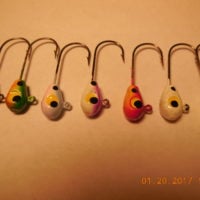I have been making non-toxic jigs for the past couple of years from 100 percent bismuth. I see where many commercially available non-toxic jigs are made from a combination of bismuth and tin. Has anyone else tried this combination and if so what ratio of bismuth to tin do you use?
IDO » Forums » Fishing Forums » General Discussion Forum » Making Non-toxic Jigs
Making Non-toxic Jigs
-
January 20, 2017 at 6:27 am #1667058
Isn’t bismuth rather expensive to buy ?
Where do you get yours ?
January 20, 2017 at 8:06 am #1667091Interesting. I’ve thought about pouring some jigs using Bismuth but have never followed through with it. I have poured some jigging spoons using pure Tin. How does working with Bismuth compare to working with lead or Tin ?
From what I have read , Bismuth is very brittle. Have you found that to be an issue with the jigs you have made ? I believe Tin is added as a sort of binder to help with the brittleness issue ?
Sorry, I can’t help with any Tin to Bismuth ratios. My guess would be that you wouldn’t have to add a lot of Tin to the mix but I really don’t know.
January 20, 2017 at 10:44 am #1667150Bismuth is rather expensive compared to lead. I purchase mine from Roto Metals on E-Bay for about $10 a pound when you buy it in 5 pound chunks. Bismuth is harder to pour than lead because it is less dense being only about 80% as dense as lead. I use a Lee production pot with a bottom pour spout. The bismuth doesn’t pour as fast as lead, but does have a lower melting point around 520 degrees F compared to lead at about 620 degrees F. I haven’t noticed any issues with the jigs being brittle or separating from the hooks. I was just curious as to what would be a good ratio of bismuth to tin. Guess maybe will order some tin and try a few different combinations.
January 20, 2017 at 10:56 am #1667164Skeeter can you post a picture of one poured please, do they come as smooth as a lead head does ?
January 20, 2017 at 1:05 pm #1667208I bought my Tin from Rotometals. I got the cut wire chunks VS bar. It’s very easy to work with in small bits like that. It’s different than working with lead as far as cutting the sprues off the freshly poured jigs etc but it’s not a big deal.
Good to know that you have not had any separation or cracking issues using Bismuth. I had read somewhere along the lines that cracking could be an issue if you fish Bismuth jigs or weights on rocky bottom.
I hope you find an answer to your question. I would be interested to see what you come up with. Maybe somebody on TU would know ???
January 20, 2017 at 2:22 pm #1667225Tumar, I don’t have any raw jigs left from last winters pour. They were all painted for use last spring on our annual Canadian trip. I will say that they are a little more rough on the surface than a lead jig but not to bad. A good base coat of white, then additional coat of whatever finishing color you prefer, then a coat of epoxy, the jig will end up very smooth. I will try to enclose a picture of some of the finished jigs. Hope all goes well because I have never tried posting a picture before.
January 20, 2017 at 7:44 pm #1667280I have the same mold or one close it and I dont use any stick on eyes so to clean up the jig I ground off the eye socket nubs.
January 21, 2017 at 10:18 am #1667347The mold is a Do-It “Teardrop Jig” number 3486. You can use it with or with out the wire bait keeper. I prefer the molded eye sockets when painting eyes because they seem to hold the paint inside the depression better making for a more uniform eye.
January 21, 2017 at 5:51 pm #1667404I think one would have a little problem melting tungsten in a production pot seeing that the melting point of tungsten is 6150 degrees F.
January 21, 2017 at 7:47 pm #1667422I was wanting to try Tungsten. Anyone trying that?
It is possible to do at home !
You must be logged in to reply to this topic.
